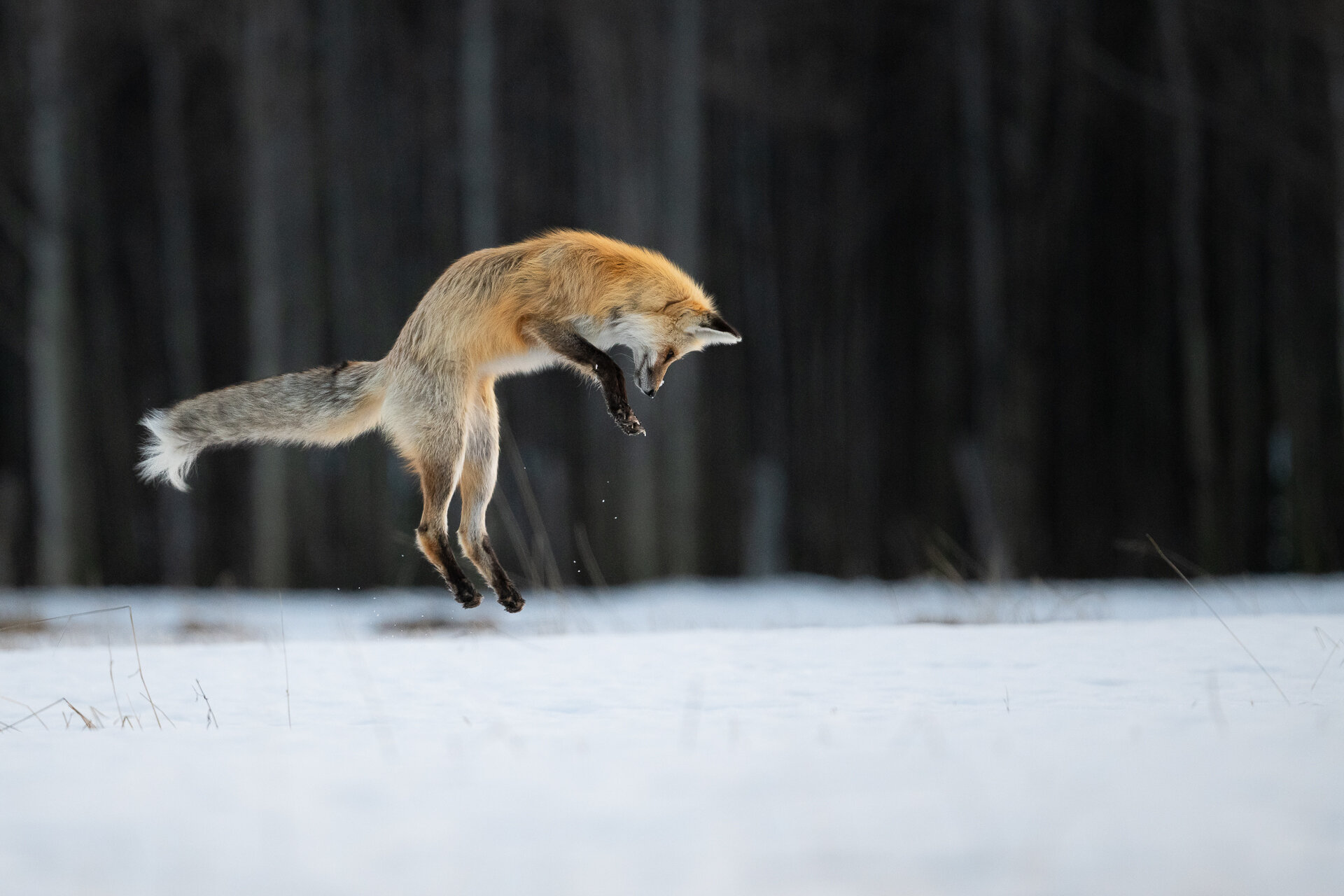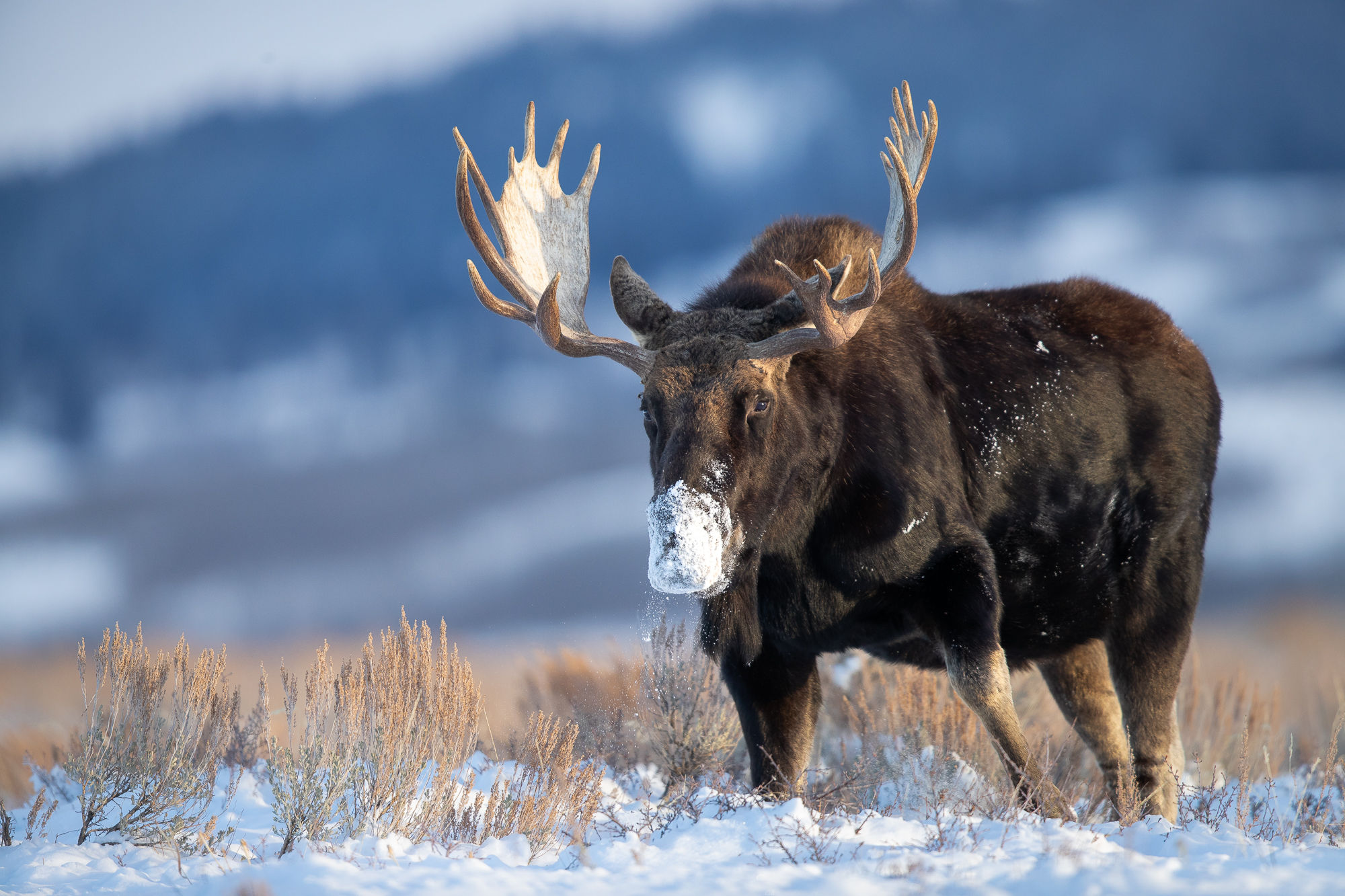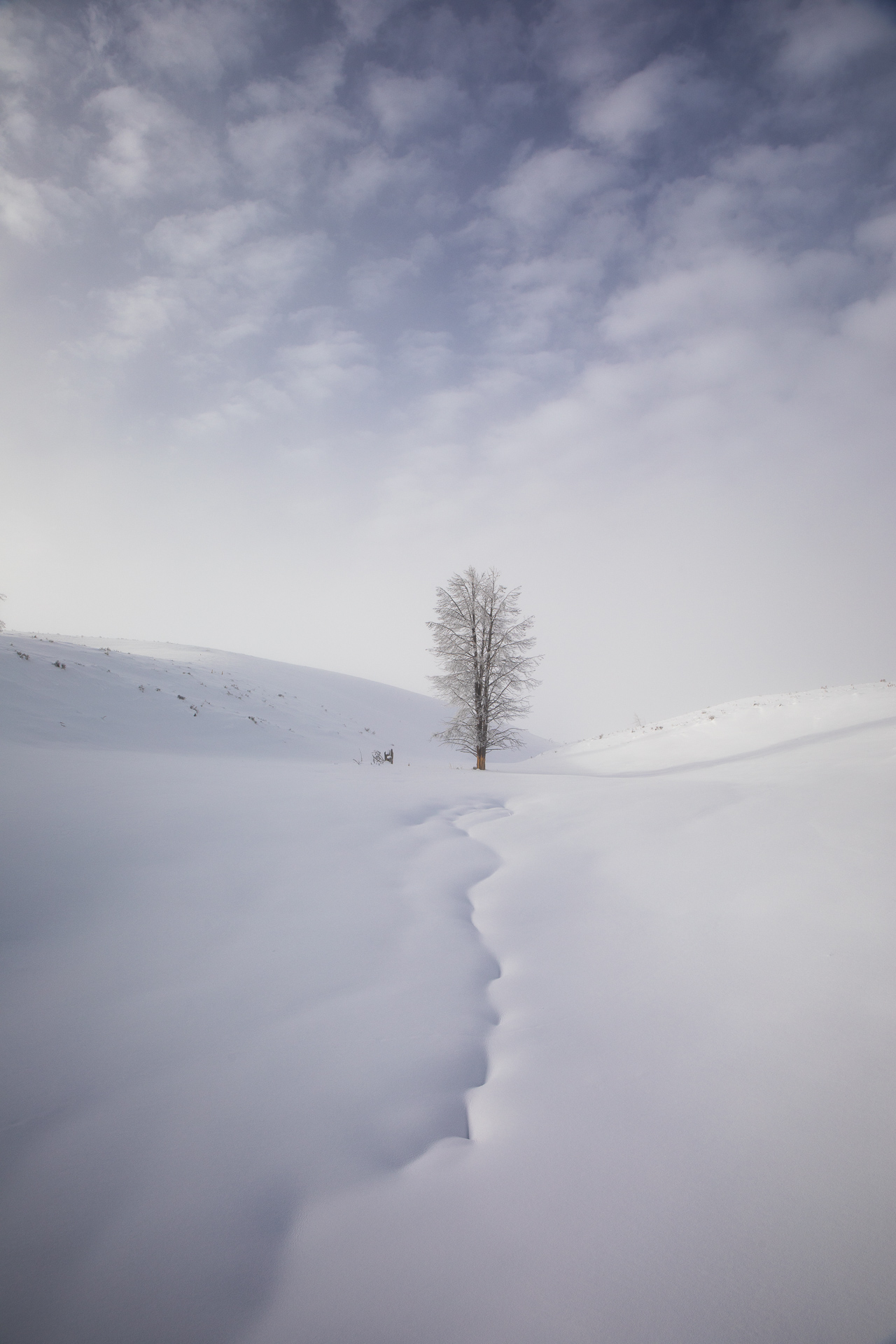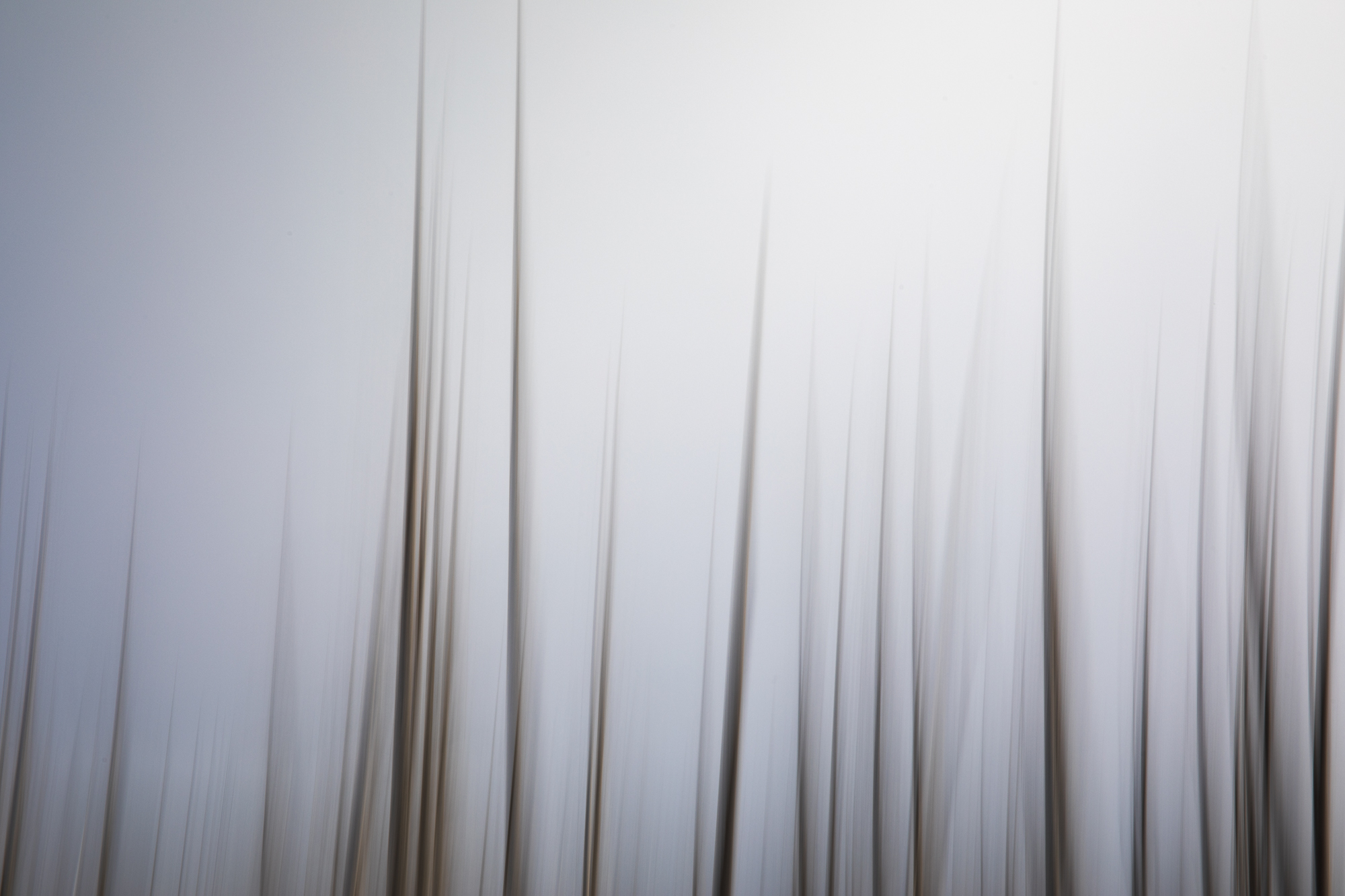It’s spring, finally. The snow is rapidly loosening it’s grip on the land. Pocket gophers and voles are still hunkered down beneath the small white patches that remain, and this experienced red fox is taking advantage of the cover that provides for hunting. Stay tuned to see whether she was successful...
Presence of the Canada Lynx
Besides the shocking disproportionate size of their feet, the calm and mesmerizing presence of the Canada Lynx is what stands out to me. Unlike most other cat species, the lynx I’ve encountered appear to be relatively comfortable with me, often sitting down and watching me before stealthily vanishing into the forest cover.
Sunrise on the Firehole River
Sunrise on the Firehole River in Yellowstone. Yellowstone has no shortage of breathtaking rivers, but the Firehole is certainly chief among. Here, the water pools up before a waterfall plunges into a canyon.
Falling snow collects on a bull moose as he browses in sagebrush flats
Great Grey Owl in Grand Teton
The phantom of the north hunts the tree line during a snow storm at dusk. Great grey owls may sit perched for hours patiently listening for a rustle of movement beneath the snow.
A small tree growing up under a big shadow
What do moose eat in the winter?
Visitors to the Greater Yellowstone often look at the vast sagebrush and wonder what purpose it serves...other than catching your feet and tripping you on every step. Actually, this ecological community supports a remarkable diversity of wildlife. For example, sage brush flats provide critical winter habitat for moose. Such as the bull moose pictured here browsing on bitterbrush.
Tetons after a winter storm
The Grand Teton the morning after a winter storm. Seen here from the western side.
Ermine
Catching a glimpse of these little guys is always a treat...one that never lasts long. This is an ermine. Their coat turns from brown to white each winter, allowing them to be nearly invisible as they move through a snow white landscape. Their tail has a black tip on the end, which functions as a decoy luring any potential predators to strike there, rather than a more vulnerable part of the body.
Bull Bison in Grand Teton
This may be my favorite thing to see in the winter...a big bull bison covered in frost. The winter coat of a bison is so well insulating that there isn’t enough heat escaping their body to melt the frost. I’ve been able to photograph this bull several times over the last couple years. His exceptionally red coat, and the red patch on his face, make him easily recognizable.
Idaho Farmland
The simple clean landscape of the Idaho farmland near Driggs, ID.
Bighorn Rams in Jackson Hole
Bighorn sheep are fairly elusive for most of the year, as they spend most of their time in the mountains. In the winter they are forced down to lower elevations to feed and become much more visible.
Solitude - Winter in Yellowstone
Hayden Valley has always been my favorite region of Yellowstone, but photographing it all alone in the quiet of winter is an unforgettable and altogether different experience. We photographed this tree on one my recent photo tours.
Bobby Sock Abstract in Yellowstone
I tried a slightly different approach to bobby socks trees in Yellowstone. I’ve always loved this stand and how symmetrical they are. The temps weren’t cold enough for fog this morning, so I used a motion blur technique to soften the image a bit.
Soaring over the Tetons
A Bald Eagle circles in front of the Teton range to make a second attempt at the raft of coots floating in the lake below.
Red Fox in Grand Teton
There are few things I find more visually striking than a red fox against the white snow. I found this fox as it was hunting for rodents under the snow. The fox will listen carefully for movement under the snow, turning its head back and forth to pin point the sound before leaping into the air and diving head first into the snow.
Tetons over Idaho
A slightly different view of the Teton Range...seen here from the western side towering over Idaho farmlands.
Lodgepole Pine
Lodgepole pine dominates the Greater Yellowstone landscape. The drastically varying heights of the trees are a poignant reminder of a powerful force in the ecosystem, that of fire. This remaining stand of trees high above the Madison River has always impressed me. These few trees somehow survived while everything around them burned to the ground. Though we feel a sense of loss after a major burn, fire is not necessarily a bad thing, nor does it get the last say when it comes to these trees.
The lodgepole pine is equipped to respond to fire in a remarkable way. Their secret is found in a condition called serotiny. Now that we got the fancy word out of the way, what does it even mean? Many of the female cones produced by lodgepole pine remain closed, until they are met with the extreme heat of a fire, at which time the cones open and disperse seeds all over the forest floor. This is why you see such a high density of young trees growing in areas that have previously burned. The smaller trees pictured in the foreground here are 30 years old! They have a long way to go before reaching the heights of their forbears.
The lodgepole pine, making up 80% of the Yellowstone forest, is remarkably resilient in its ability to grow in less than ideal conditions. Here, the poor conditions eventually took their toll. The wet and mineral laden sulfuric soil around hydrothermal features is a tough place to survive.
These trees are known as bobby socks trees because of the white section on the lower trunk which resembles bobby socks. As the trees absorb the water from hydrothermal runoff they also take in minerals. When the water evaporates, the minerals remain and turn the bottom of the trees white.
Grizzly 399
This was my last sighting of grizzly 399 and her two cubs for the season as she made the most of gut piles left over from hunters. It looks like she has denned up for the winter. She was the very first grizzly I saw and photographed. I grew up spending my summers in Jackson, and dreamed of seeing a grizzly from my earliest days, but it took a while. When I finally turned 16 and got my driver’s license I had a little bit more flexibility. With that I was able to go into the field on my own schedule and spend all the time I wanted waiting around. That was the summer I saw her. I remember the adrenaline and excitement like it was yesterday. She will always be very special to me, and I know there are many people who feel similarly.
Spirit Bear - The Catch
A spirit bear snags a silver salmon. Biologists think the white coat makes them more successful when fishing. From the perspective of a fish looking through white water and upwards to the sky, it is a lot easier to detect a black coat, than a white one.
After snorkeling and successfully catching a Silver Salmon, a Spirit Bear shakes off his wet coat. It took me four trips to the Great Bear Rainforest before I had the privilege of photographing the Spirit Bear. It is a rare subspecies of black bear that lives only along the central and northern coast of BC. There are less than 400 Spirit bears in existence, making them one of the rarest bears on the planet.

























